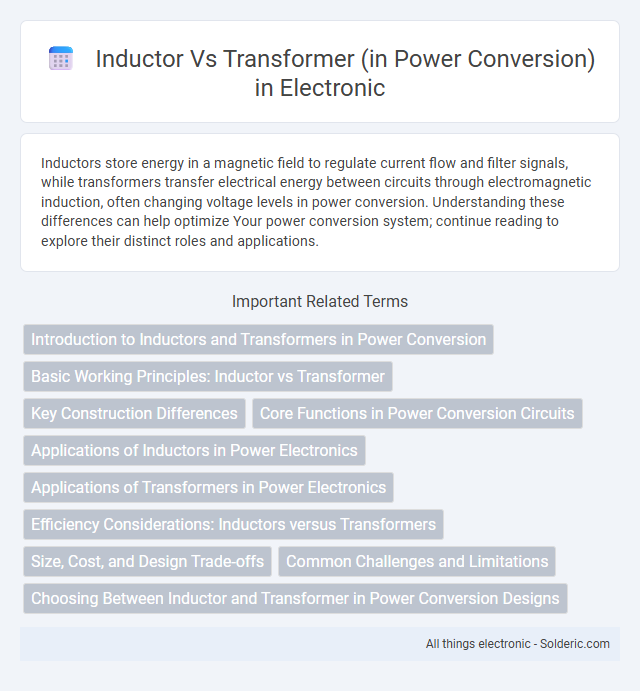Inductors store energy in a magnetic field to regulate current flow and filter signals, while transformers transfer electrical energy between circuits through electromagnetic induction, often changing voltage levels in power conversion. Understanding these differences can help optimize Your power conversion system; continue reading to explore their distinct roles and applications.
Comparison Table
| Feature | Inductor | Transformer |
|---|---|---|
| Function | Stores energy in magnetic field during power conversion | Transfers electrical energy between circuits via magnetic coupling |
| Primary Use | Energy storage, filtering, smoothing current | Voltage step-up/step-down, isolation, impedance matching |
| Number of Windings | Single winding coil | Two or more windings (primary and secondary) |
| Voltage Conversion | Does not change voltage level significantly | Changes voltage ratio according to turns ratio |
| Isolation | No electrical isolation | Provides electrical isolation between circuits |
| Application in Power Conversion | Boost converters, filter chokes, energy storage | AC-DC converters, DC-DC converters, power supplies |
| Frequency Range | Low to high frequencies depending on design | Typically used in AC or high-frequency switching power supplies |
| Core Material | Ferrite, iron powder, or air core | Ferrite, laminated iron core for magnetic coupling |
Introduction to Inductors and Transformers in Power Conversion
Inductors and transformers are essential components in power conversion systems, playing distinct roles in energy storage and voltage transformation. An inductor stores energy in a magnetic field when current flows through it, aiding in filtering and smoothing electrical signals. Transformers transfer electrical energy between circuits through electromagnetic induction, enabling voltage level adjustments critical for efficient power distribution in your applications.
Basic Working Principles: Inductor vs Transformer
An inductor stores energy in a magnetic field when current flows through its coil, providing impedance to changes in current and stabilizing voltage in power conversion circuits. A transformer transfers electrical energy between two or more coils through electromagnetic induction, enabling voltage level changes and isolation in AC power systems. While inductors are primarily used for energy storage and filtering, transformers enable efficient voltage scaling and galvanic isolation in power conversion applications.
Key Construction Differences
Inductors consist of a single coil wound around a core, typically made of ferromagnetic material or air, designed to store energy in its magnetic field, while transformers feature two or more coils (primary and secondary) wound around a common magnetic core to transfer energy between circuits via electromagnetic induction. The magnetic core in transformers is engineered to maximize magnetic coupling and minimize losses, enabling efficient voltage transformation, whereas in inductors, the core focuses on enhancing inductance and energy storage. Windings in transformers are electrically isolated from each other to allow voltage transformation, contrasting with the single continuous winding of inductors.
Core Functions in Power Conversion Circuits
Inductors store energy in a magnetic field during power conversion and release it to smooth current flow, essential for filtering and energy transfer in DC-DC converters. Transformers transfer electrical energy between circuits through electromagnetic induction, enabling voltage level changes and providing isolation in AC power systems. Understanding the distinct core functions of inductors and transformers helps optimize Your power conversion circuit design for efficiency and performance.
Applications of Inductors in Power Electronics
Inductors in power electronics are primarily used for energy storage, filtering, and controlling current flow in DC-DC converters, such as buck, boost, and buck-boost topologies. They play a critical role in smoothing voltage and reducing electromagnetic interference (EMI) by maintaining continuous current and minimizing ripple. Applications include power supplies for computers, electric vehicles, and renewable energy systems where efficient energy transfer and noise reduction are essential.
Applications of Transformers in Power Electronics
Transformers are critical components in power electronics, enabling voltage level adjustments to match application requirements in devices like AC-DC adapters, inverters, and power supplies. They provide galvanic isolation to enhance safety and reduce electromagnetic interference in circuits. Your power conversion system relies on transformers for efficient energy transfer, voltage regulation, and improved performance in both industrial and consumer electronics.
Efficiency Considerations: Inductors versus Transformers
Inductors typically exhibit higher efficiency in power conversion due to lower core losses and simpler construction, making them ideal for energy storage and filtering applications. Transformers, while essential for voltage level changes and isolation, often experience additional losses from hysteresis, eddy currents, and winding resistance, which can reduce overall efficiency. Careful material selection and design optimization are critical to minimizing these losses and achieving efficient power transfer in transformers.
Size, Cost, and Design Trade-offs
Inductors are typically smaller and less expensive than transformers, making them ideal for compact power conversion designs where size and cost are critical factors. Transformers offer voltage isolation and multiple winding options but require larger cores and more complex windings, increasing size and cost. Your design choice depends on whether isolation and voltage transformation outweigh the benefits of reduced size and cost provided by inductors.
Common Challenges and Limitations
Inductors in power conversion often face challenges related to core losses, saturation, and thermal management, limiting their efficiency and size reduction. Transformers share similar issues but additionally encounter leakage inductance and parasitic capacitance, complicating high-frequency operation and voltage regulation. Both components require careful design trade-offs to balance magnetic performance, thermal dissipation, and electromagnetic interference in compact power systems.
Choosing Between Inductor and Transformer in Power Conversion Designs
Choosing between an inductor and a transformer in power conversion designs depends on your specific application requirements, such as voltage transformation, isolation, and energy storage. Inductors are ideal for energy storage and filtering in DC-DC converters, offering simplicity and efficiency, while transformers provide voltage scaling and galvanic isolation crucial for AC power systems and isolated DC-DC converters. Understanding your design's voltage levels, isolation needs, and frequency operation helps determine whether an inductor or transformer is the optimal component.
inductor vs transformer (in power conversion) Infographic

 solderic.com
solderic.com